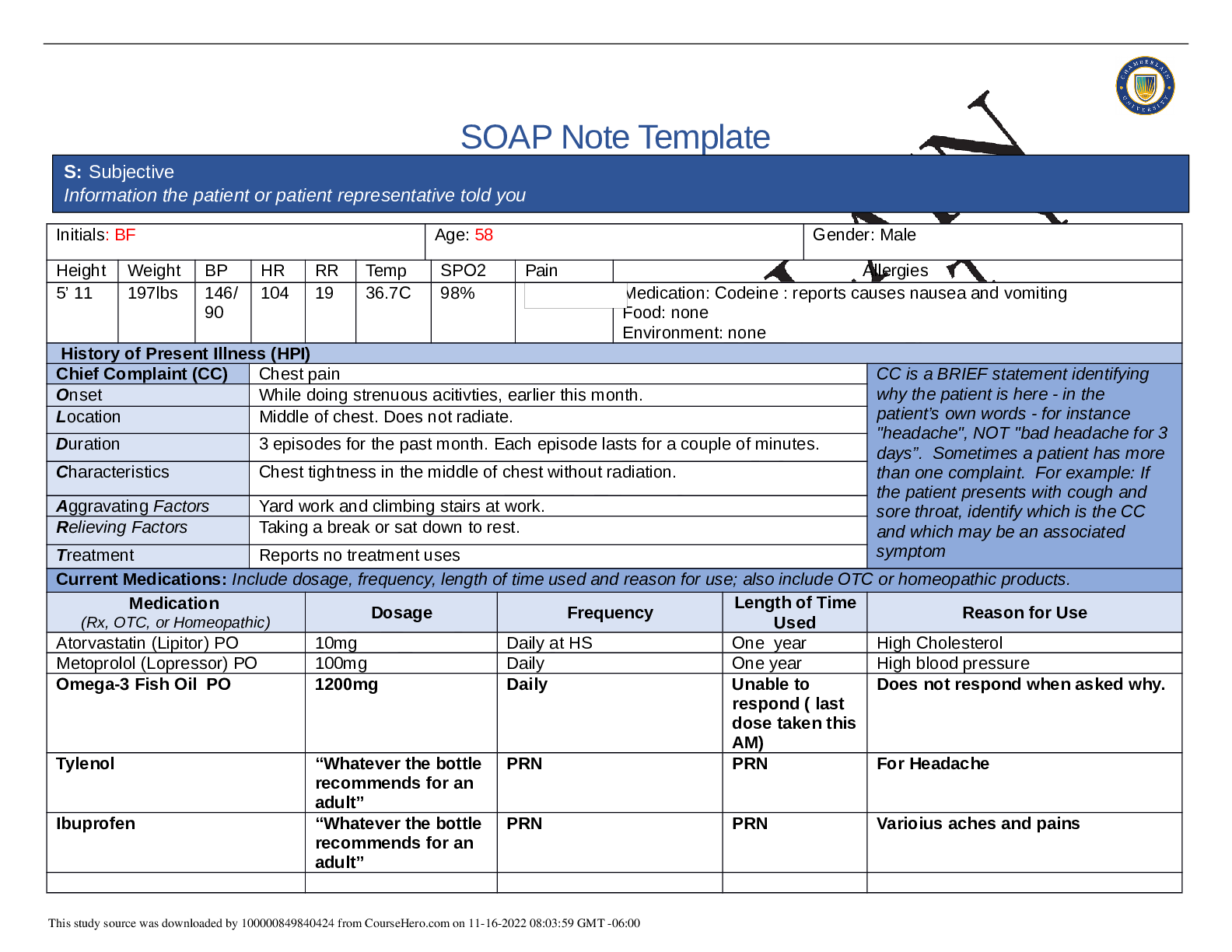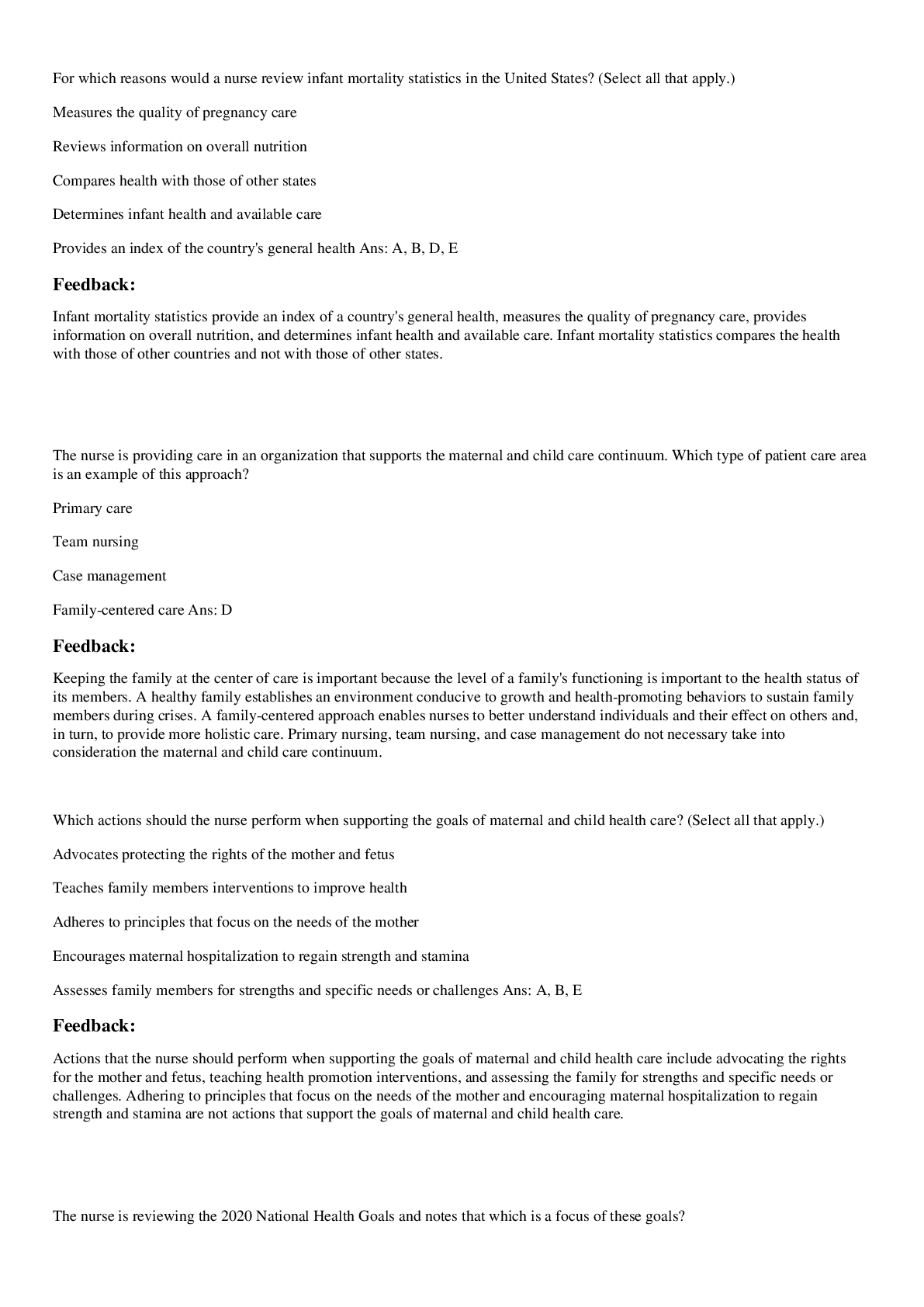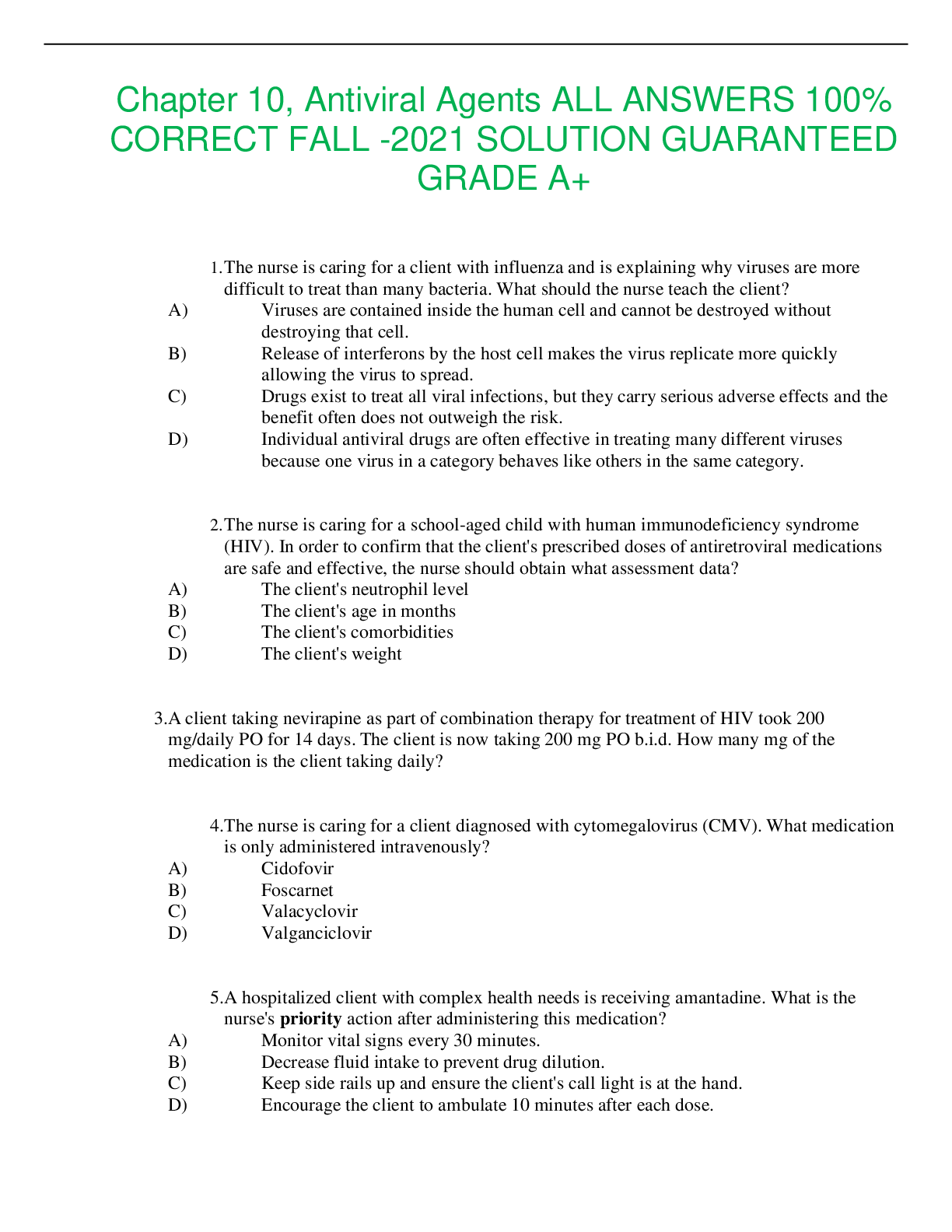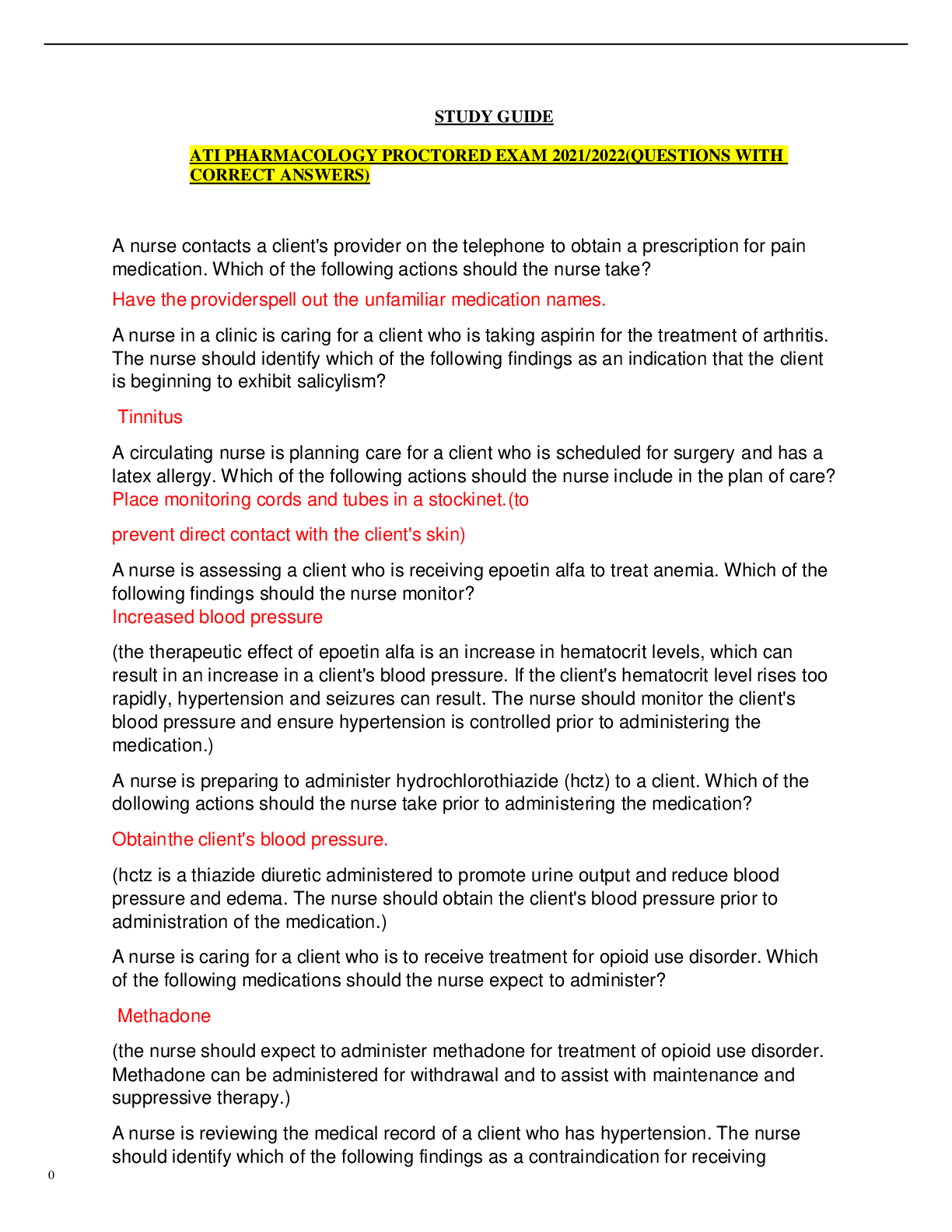Health Care > QUESTIONS and ANSWERS > NR 602 Final ALL ANSWERS 100% CORRECT FALL -2021LATEST SOLUTION GUARANTEED GRADE A+ (All)
NR 602 Final ALL ANSWERS 100% CORRECT FALL -2021LATEST SOLUTION GUARANTEED GRADE A+
Document Content and Description Below
Eye disorders: Chalazion (caused by noninfectious occlusion) or Hordeolum (caused by infection). However, a hordeolum will be painful. Both can be treated with heat compresses. At birth the maxillary... and ethmoid sinuses are typically developed and pneumatized. By 9 months to a year of age the sphenoid sinuses typically become pneumatized, and by 5 years of age, the frontal sinuses are pneumatized. Frontal sinuses continue to grow as the face grows and may be larger in boys. Up to 10% of the population does not develop frontal sinuses. Nosebleeds can be traumatic for both parents and children. A small amount of blood can look like a great deal, which can be frightening. Quite vascular, at Kiesselbach's plexus in the front- septal area. Common site for bleeds to occur. Causes of epistaxis include but are not limited to picking, trauma, dry environment, treatment with topical nasal steroids, and vigorous rubbing or blowing. Even though less than 5% of children with reoccurring epistaxis have a bleeding disorder, this should not be excluded from the differential in cases of repetitive and significant epistaxis. Treatment includes having the patient sit up and then apply gentle-pinching pressure to the soft area of the nose below the nasal bones for at least 5 minutes. If still bleeding take to MD. Soft packing, such as gel foam, can be inserted to absorb and prevent further bleeding. Prevention includes keeping the nares moist with saline nasal gel or spray daily, humidifying the environment, and ensuring that nasal medications are being used appropriately Bulbar or palpebral conjunctival injection is a common presentation, which can be unilateral or bilateral. The differential diagnosis should include allergy, conjunctivitis, infection, foreign body, chemical exposure, or systemic inflammatory disease, irritation of the conjunctiva or cornea, and congenital glaucoma. Therefore, a good examination for symptoms associated with each is needed. Discharge from the eye varies based on cause. Watery discharge can occur with allergies, nasolacrimal obstruction, foreign bodies, viral infection, and iritis. However, purulent or mucoid discharge can be noted with chronic dacrocystitis or nasolacrimal obstruction. Even advanced allergic conjunctivitis can have some mucoid production. To differentiate, microscopic investigation of discharge may lead to other clues. The eye is one of the most sensitive areas of the body and pain can occur for many reasons. The NP should always complete a thorough exam for trauma, foreign bodies, even trichiasis. Photophobia is a symptom common of trauma and in infants with glaucoma or retinal disease. Other non-eye related causes of photophobia include migraines and meningitis. A white pupil, or leukocoria, is a serious finding and demands immediate referral to the pediatric ophthalmologist. Causes of leukocoria include retinal detachment, cataract, retinal dysplasia, retinopathy of prematurity, and in newborns retinoblastoma. All newborns should have a fundoscopic examination within 24 hours of birth and yearly on physical examinations. Some children are at higher risk for the need of glasses, including those with Down syndrome, Marfan syndrome, and Ehlers-Danlos syndrome. Visual screening in all children at least once between the ages of 3 and 5 is a formal recommendation of the USPSTF (2011). Summary of Recommendations and Evidence Population Recommendation Grade Children, Age 3-5 Years. The USPSTF recommends vision screening for all children at least once between the ages of 3 and 5 years, to detect the presence of amblyopia or its risk factors. B Children, <3 Years of Age The USPSTF concludes that the current evidence is insufficient to assess the balance of benefits and harms of vision screening for children <3 years of age. Common eye traumas that may present to primary care are as follows: o Scratch or laceration to the cornea o Blunt trauma to the orbit; note that an orbital fracture can cause muscle entrapment, compartment syndrome o Hyphema o Chemical or heat-related burns o URIs often have peak incidence in winter and spring months when communicability from indoor exposure is highest. o Common symptoms include congestion, sore throat, rhinorrhea that can progress in color and amount as the URI progresses, but does not mean that bacterial sinusitis is present, and cough. Also, symptoms may include possibly sneezing, myalgia, or low-grade fever. o Current treatment, particularly for young children, is hydration and over-the- counter antipyretics for low-grade fever or myalgia as directed by the provider. o Normal saline rinse of the nares may be of some benefit and clearing congestion but may not be well tolerated by some children. Currently, cold and cough recommendations are not recommended in children younger than age 4. o Complications of URIs include otitis media and sinusitis. Presumptive antibiotics should not be given to prevent these complications. Sinusitis in children cannot be diagnosed until at least 10 to 14 days with lack of symptom improvement or development of new symptoms, such as facial pain. o Children with Asthma should be monitored for exacerbation and may need home monitoring of peak flow and symptoms or initiation of their asthma action plan for changes in the airway. Bacterial Rhinosinusitis Caused by common URI infection. These children typically worsen after 5 to 7 days of a URI or are not resolved in 2 weeks. Children with a history of respiratory allergies or trauma may be at higher risk. Symptoms should be present more than 10 days or worsen within 10 days after initial improvement and include purulent nasal congestion, nasal drainage, facial pain, headache, purulent posterior pharyngeal drainage, and fever. Musculoskeletal Injuries – assessment and treatment: Ch 43 ● Bone age – radiographs of left hand and wrist ➢ Used to determine somatic maturation, and Measure of growth tempo ● Skeletal growth spurt in adolescents ➢ Tanner stage 2 in girls, and Tanner stage 3 in boys ● Long bones have growth plate (physis); blood supply through epiphysis; damage to epiphysis can stop growth of bone (Fig. 43.1) ● Bone, muscle development influenced by use ➢ Protein, calcium, vitamin D necessary for growth and development of musculoskeletal system ● Pathophysiology: Systemic problems ➢ Infection – viral, bacterial, tubercular ➢ Hemophilia, sickle cell disease, arthritic disease ➢ Malignancy ● Genetic problems ➢ Osteogenesis imperfecta ➢ Down syndrome ➢ Marfan syndrome ➢ Growth plate fx’s ➢ Salter-Harris classification ● Mechanism of injury ● Fracture line related to layers of physis ● Prognosis for subsequent growth disturbance (rare in Types I and II) ● Salter-Harris classification Salter-Harris Classification of Physical Fractures, Types I to V. ➢ Type I – fracture in physis/not surrounding bone ➢ Type II – metaphyseal fragment on compression side ➢ Type III – physeal separation – requires anatomic reduction ➢ Type IV – metaphysis, physis, epiphysis ➢ Type V – compression/crushing injury to physis ● Shaft fractures ➢ Mechanism of injury important – closed fractures while tripping; open fractures with more force ● History ➢ Onset of symptoms; history of injury using OLDCARTS ➢ Pain – location, character, effect of activities ➢ Deformity ➢ Altered function ➢ Altered gait ➢ Family history – musculoskeletal problems ➢ Medical history – pregnancy, development, illnesses, accidents, surgeries ➢ Review of systems – infections, diseases, congenital problems ● Inspection and palpation ➢ Skin color, swelling, atrophy, erythema, ecchymosis, scars, pigmentation ➢ Posture while sitting, standing, walking ➢ Evaluation of symmetry, ROM, muscle size, strength, tone ➢ Reflexes, spinal nerves ● Range-of-motion exam ➢ Range, flexion, extension, rotation of joint ➢ Hypermobility ● Gait examination ➢ Developmental stages ➢ Observe walking with and without shoes ➢ Compare stance and swing phases, ROM of each joint ➢ Should be smooth, rhythmic, efficient, symmetrical ➢ Limping is a disturbance in gait ➢ Disturbances may be more apparent with fatigue ● Posture ➢ Pelvis and hips should be level ➢ Legs should be symmetric in shape/size ➢ Feet should point straight ahead ➢ Spine should be straight; back should lo [Show More]
Last updated: 2 years ago
Preview 1 out of 41 pages
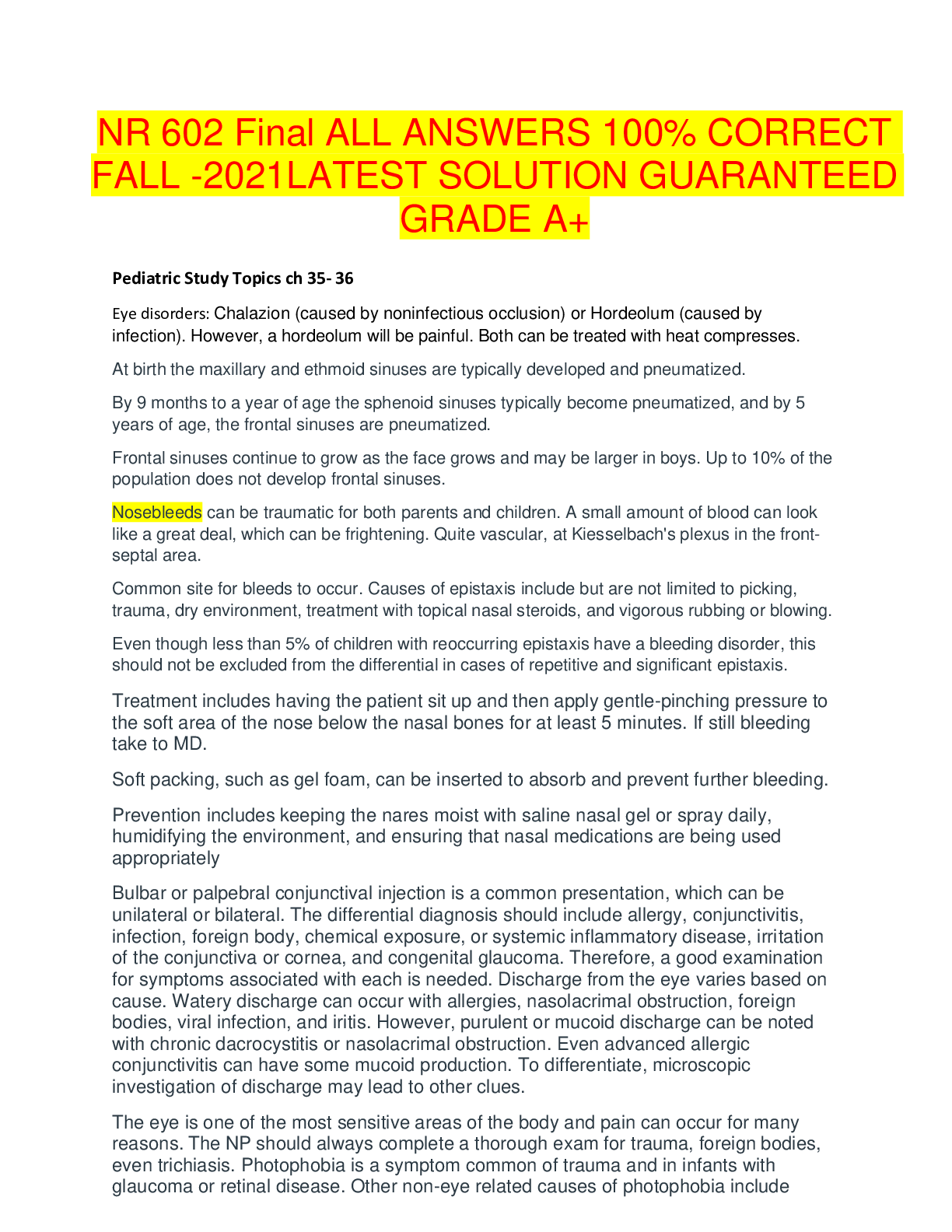
Buy this document to get the full access instantly
Instant Download Access after purchase
Buy NowInstant download
We Accept:

Reviews( 0 )
$21.50
Can't find what you want? Try our AI powered Search
Document information
Connected school, study & course
About the document
Uploaded On
Oct 25, 2021
Number of pages
41
Written in
Additional information
This document has been written for:
Uploaded
Oct 25, 2021
Downloads
0
Views
92





